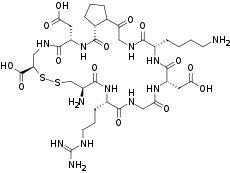iRGD
iRGD is a 9-amino acid cyclic peptide (sequence: CRGDKGPDC) and a molecular mimicry agent that was originally identified in an in vivo screening of phage display libraries in tumor-bearing mice.[1] The peptide was able to home to tumor tissues, but in contrast to standard RGD (Arginylglycylaspartic acid) peptides, also spread much more extensively into extravascular tumor tissue. It was later identified that this extravasation and transport through extravascular tumor tissue was due to the bifunctional action of the molecule: after the initial RGD-mediated tumor homing, another pharmacological motif is able to manipulate tumor microenvironment, making it temporarily accessible to circulating drugs. This second step is mediated through specific secondary binding to neuropilin-1 receptor, and subsequent activation of a trans-tissue pathway, dubbed the C-end Rule (CendR) pathway.[2]
 | |
| Clinical data | |
|---|---|
| Other names | CEND-1 |
| Routes of administration | Intravenous |
| Pharmacokinetic data | |
| Bioavailability | 100% |
| Metabolism | n/a |
| Elimination half-life | 1-3 hours |
| Duration of action | up to 24 hours |
| Excretion | Renal (100%) |
| Identifiers | |
| CAS Number | |
| PubChem CID | |
| UNII | |
| Chemical and physical data | |
| Molar mass | (989.1 g/mol after conversion) |
Mechanism of action
The iRGD peptide homes and penetrates tumors through a 3-step process: First, the RGD sequence motif mediates binding to αVβ3 and αVβ5 integrins that are expressed on tumor endothelial cells. Second, upon αV binding, a protease cleavage event is activated, revealing the c-terminal CendR motif (R/KXXR/K) of the peptide. Third, the CendR motif is now able to bind to neuropilin-1, activating an endocytotic/exocytotic transport pathway.[3] The pathway triggered by iRGD can be used for the enhanced transport of coupled and coadministered anti-cancer drugs into tumors.
Uses
iRGD peptide has been shown to increase accumulation and penetration of anticancer drugs into tumors, but not into normal tissues - whether the drug is coupled to the peptide or given together with it.[4] iRGD-mediated increased penetration and anti-cancer efficacy has been demonstrated with a variety of anti-cancer small molecules, nanoparticles and antibodies.[5] A San Diego -based biotech company, DrugCendR Inc., is currently testing iRGD in clinical studies in pancreatic cancer patients. The drug product version of iRGD is called CEND-1.[6]
References
- Sugahara KN, Teesalu T, Karmali PP, Kotamraju VR, Agemy L, Greenwald DR, Ruoslahti E (May 2010). "Coadministration of a tumor-penetrating peptide enhances the efficacy of cancer drugs". Science. 328 (5981): 1031–5. Bibcode:2010Sci...328.1031S. doi:10.1126/science.1183057. PMC 2881692. PMID 20378772.
- Ruoslahti E (February 2017). "Tumor penetrating peptides for improved drug delivery". Advanced Drug Delivery Reviews. 110-111 (Supplement C): 3–12. doi:10.1016/j.addr.2016.03.008. PMC 5045823. PMID 27040947.
- Teesalu T, Sugahara KN, Kotamraju VR, Ruoslahti E (September 2009). "C-end rule peptides mediate neuropilin-1-dependent cell, vascular, and tissue penetration". Proceedings of the National Academy of Sciences of the United States of America. 106 (38): 16157–62. Bibcode:2009PNAS..10616157T. doi:10.1073/pnas.0908201106. PMC 2752543. PMID 19805273.
- Haas MJ (29 April 2010). "Coupled, but not conjugated, in cancer". SciBX: Science-Business EXchange. 3 (17): 514. doi:10.1038/scibx.2010.514.
- Ruoslahti E (May 2017). "Access granted: iRGD helps silicasome-encased drugs breach the tumor barrier". The Journal of Clinical Investigation. 127 (5): 1622–1624. doi:10.1172/JCI93955. PMC 5409784. PMID 28414298.
- Clinical trial number NCT03517176 for "CEND-1 in Combination With Nabpaclitaxel and Gemcitabine in Metastatic Pancreatic Cancer" at ClinicalTrials.gov